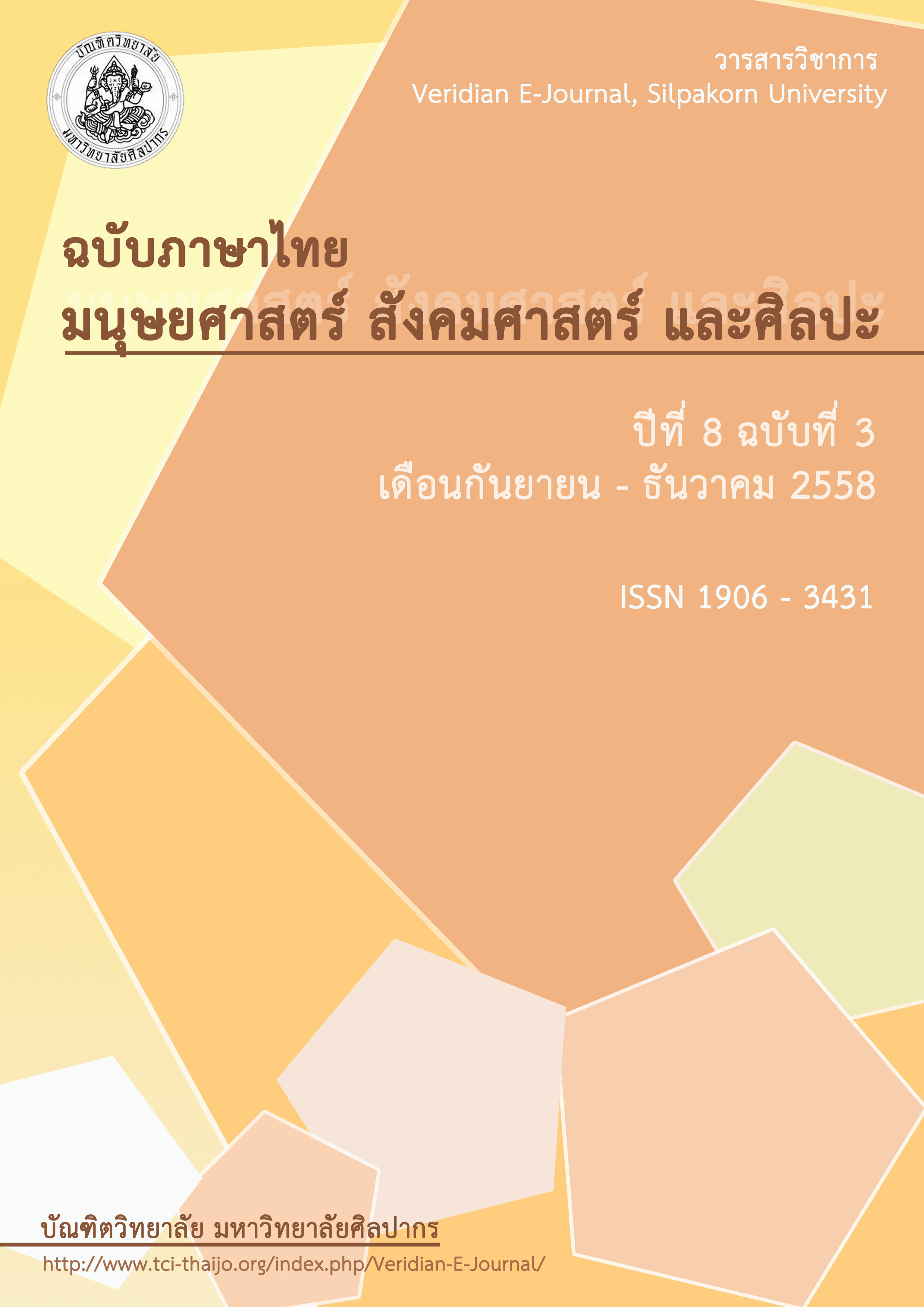ผลการเรียนแบบผสมผสานด้วยการเรียนแบบร่วมมือ วิชาคอมพิวเตอร์ที่มีต่อความรู้พื้นฐานด้านสื่อ และการทำงานร่วมกับผู้อื่น ของนักเรียนชั้นประถมศึกษาปีที่ 6
Main Article Content
Abstract
บทคัดย่ฮ
การวิจัยครั้งนี้มีวัตถุประสงค์เพื่อ1) ศึกษาความรู้พื้นฐานด้านสื่อหลังเรียนของนักเรียนชั้นประถมศึกษาปีที่ 6 ที่เรียนด้วยการเรียนแบบผสมผสานด้วยการเรียนแบบร่วมมือวิชาคอมพิวเตอร์ 2) เพื่อศึกษาความสามารถในการทำงานร่วมกับผู้อื่น ของนักเรียนชั้นประถมศึกษาปีที่ 6 ที่เรียนด้วยการเรียนแบบผสมผสานด้วยการเรียนแบบร่วมมือ วิชาคอมพิวเตอร์ 3) เพื่อศึกษาความพึงพอใจของนักเรียนชั้นประถมศึกษาปีที่ 6 ที่เรียนด้วยการเรียนแบบผสมผสานด้วยการเรียนแบบร่วมมือ วิชาคอมพิวเตอร์ กลุ่มตัวอย่างที่ใช้ในการวิจัยเป็นนักเรียนชั้นประถมศึกษาปีที่ 6 ห้อง 1 ภาคเรียนที่ 2 ปีการศึกษา 2557 โรงเรียนวัดราษฎร์รังสรรค์จำนวน 30 คน ได้มาโดยวิธีการสุ่มอย่างง่าย (Simple Random Sampling)เครื่องมือที่ใช้ในการวิจัยครั้งนี้ ได้แก่ 1) แบบสัมภาษณ์แบบมีโครงสร้าง 2) แผนการจัดการเรียนรู้การเรียนแบบผสมผสานด้วยการเรียนแบบร่วมมือ 3) บทเรียนอีเลิร์นนิงสำหรับการเรียนแบบผสมผสาน 4) แบบทดสอบวัดความรู้พื้นฐานด้านสื่อ และแบบประเมินความสามารถในการผลิตสื่อ 5) แบบประเมินความสามารถในการทำงานร่วมกัน 6) แบบสอบถามความพึงพอใจที่มีต่อการเรียนแบบผสมผสานด้วยการเรียนแบบร่วมมือ วิชาคอมพิวเตอร์ การวิเคราะห์ข้อมูลใช้ ค่าเฉลี่ย ( ) ค่าส่วนเบี่ยงเบนมาตรฐาน (S.D.) และการทดสอบค่าที (t-test) แบบ Dependent Samples
ผลการวิจัยพบว่า1) ความรู้พื้นฐานด้านสื่อของนักเรียนที่เรียนแบบผสมผสานด้วยการเรียนรู้แบบร่วมมือวิชาคอมพิวเตอร์ ก่อนเรียนและหลังเรียนแตกต่างกันอย่างมีนัยสำคัญทางสถิติที่ระดับ 0.01 โดยคะแนนหลังเรียนสูงกว่าก่อนเรียน และความสามารถในการผลิตสื่อ มีคะแนนรวมเฉลี่ยอยู่ในระดับปานกลาง 2) ความสามารถในการทำงานร่วมกับผู้อื่นของนักเรียนที่เรียนด้วยการเรียนแบบผสมผสานด้วยการเรียนแบบร่วมมือวิชาคอมพิวเตอร์มีคะแนนรวมเฉลี่ยอยู่ในระดับมาก ( =2.70,S.D.=0.09) และความพึงพอใจ ของนักเรียนที่เรียนด้วยการเรียนแบบผสมผสานด้วยการเรียนแบบร่วมมือ วิชาคอมพิวเตอร์ มีคะแนนรวมเฉลี่ย อยู่ในระดับมาก ( =2.86, S.D. =0.28)
Abstract
The objectives of this research were: 1) to study media literacy posttest of Phatomsuksa 6 students with blended learning using cooperative learning oncomputer subject, 2) to study cooperative skills of Phatomsuksa 6 students with blended learning using cooperative learning on computer subject, and 3) to study satisfaction of Phatomsuksa 6 students with blended learning using cooperative learning on computer subject. The sample consisted of 30 students of Phatomsuksa 6 during the academic year 2014 at Watradrangson School. Samples were selected by simple random sampling method. The instruments of this research were: 1) a structure interview, 2) a lesson plan on blended learning by cooperative learning, 3) an e-Learning system by blended learning,4) a test of media literacy and evaluation of ability to produce media, 5) an evaluation from cooperative skills, 6) a questionnaire for satisfaction of blended learning by cooperative learning on computer subject.The data analysis were mean ( ), standard deviation (S.D.) and t-test Dependent Samples.The results of this research were as follows: 1) the differences of pretest and posttest of the ability of media literacy with blended learning by cooperative learning was statistically significant at the 0.01 level which the posttest was higher than the pretest and the ability to produce media was at the middle level, 2) cooperative skills of student with blended learning by cooperative learning on computer subject was the high level ( =2.70, S.D.=0.09), and 3) the student’s satisfaction with blended learning by cooperative learning on computer subject was the high level. ( =2.86, S.D. =0.28)

